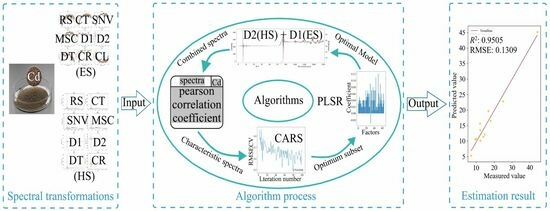Quantitative Analysis of Soil Cd Content Based on the Fusion of Vis-NIR and XRF Spectral Data in the Impacted Area of a Metallurgical Slag Site in Gejiu, Yunnan
Abstract
:1. Introduction
2. Materials and Methods
2.1. Study Area
2.2. Data Collection
2.2.1. Soil Sample Collection
2.2.2. Chemical Analysis
2.2.3. Measurement of vis-NIR Spectra Using a Portable Spectrometer
2.2.4. Measurement of XRF Spectra Using an X-ray Fluorescence Spectrometer
2.3. Data Analysis
2.3.1. Spectral Pre-Processing Methods
2.3.2. Feature Spectral Selection
2.3.3. Estimation Model
2.3.4. Accuracy and Efficiency Evaluation
2.3.5. Building a Spectral Fusion Model
3. Results
3.1. Descriptive Statistical Analysis
3.1.1. Descriptive Statistical Analysis of Soil Cd Concentration
3.1.2. Descriptive Analysis of Spectral Curves
3.2. Feature Spectrum Selection
3.2.1. Preliminary Feature Spectrum Selection Based on PCC
3.2.2. Feature Spectrum Selection Based on CARS Algorithm
3.3. Evaluation of Estimation Model Accuracy and Efficiency
3.3.1. Evaluation of Single-Spectrum Estimation Models
3.3.2. Evaluation of Spectral Fusion Models
4. Discussion
5. Conclusions
Supplementary Materials
Author Contributions
Funding
Data Availability Statement
Acknowledgments
Conflicts of Interest
References
- Tian, L.; Liu, X.; Zhang, B.; Liu, M.; Wu, L. Extraction of Rice Heavy Metal Stress Signal Features Based on Long Time Series Leaf Area Index Data Using Ensemble Empirical Mode Decomposition. Int. J. Environ. Res. Public Health 2017, 14, 1018. [Google Scholar] [CrossRef]
- Liu, M.; Liu, X.; Zhang, B.; Ding, C. Regional Heavy Metal Pollution in Crops by Integrating Physiological Function Variability with Spatio-Temporal Stability Using Multi-Temporal Thermal Remote Sensing. Int. J. Appl. Earth Obs. Geoinf. 2016, 51, 91–102. [Google Scholar] [CrossRef]
- Zhao, F.J.; Ma, Y.; Zhu, Y.G.; Tang, Z.; McGrath, S.P. Soil Contamination in China: Current Status and Mitigation Strategies. Environ. Sci. Technol. 2015, 49, 750–759. [Google Scholar] [CrossRef]
- Xu, M.X.; Wu, S.H.; Zhou, S.L.; Liao, F.Q.; Ma, C.-M.; Zhu, C. Hyperspectral reflectance models for retrieving heavy metal content: Application in the archaeological soil. J. Infrared Millim. Waves 2012, 30, 109–114. [Google Scholar] [CrossRef]
- Jia, Z.; Li, S.; Wang, L. Assessment of Soil Heavy Metals for Eco-Environment and Human Health in a Rapidly Urbani-zation Area of the Upper Yangtze Basin. Sci. Rep. 2018, 8, 3256. [Google Scholar] [CrossRef]
- Wang, F.; Gao, J.; Zha, Y. Hyperspectral Sensing of Heavy Metals in Soil and Vegetation: Feasibility and Challenges. ISPRS J. Photogramm. Remote Sens. 2018, 136, 73–84. [Google Scholar] [CrossRef]
- Wu, Y.; Chen, J.; Wu, X.; Tian, Q.; Ji, J.; Qin, Z. Possibilities of Reflectance Spectroscopy for the Assessment of Contaminant Elements in Suburban Soils. Appl. Geochem. 2005, 20, 1051–1059. [Google Scholar] [CrossRef]
- Liu, M.; Liu, X.; Wu, L.; Duan, L.; Zhong, B. Wavelet-Based Detection of Crop Zinc Stress Assessment Using Hyperspectral Reflectance. Comput. Geosci. 2011, 37, 1254–1263. [Google Scholar] [CrossRef]
- Zhang, Y.; Hartemink, A.E. Data Fusion of Vis-NIR and PXRF Spectra to Predict Soil Physical and Chemical Properties. Eur. J. Soil Sci. 2020, 71, 316–333. [Google Scholar] [CrossRef]
- Kemper, T.; Sommer, S. Estimate of Heavy Metal Contamination in Soils after a Mining Accident Using Reflectance Spectroscopy. Environ. Sci. Technol. 2002, 36, 2742–2747. [Google Scholar] [CrossRef]
- GB15618–2018; Environmental Quality Standards for Soils. MEPRC (Ministry of Environmental Protection of the People’s Republic of China). MEP: Beijing, China, 2018. (In Chinese)
- Shi, T.; Chen, Y.; Liu, Y.; Wu, G. Visible and Near-Infrared Reflectance Spectroscopy—An Alternative for Monitoring Soil Con-tamination by Heavy Metals. J. Hazard. Mater. 2014, 265, 166–176. [Google Scholar] [CrossRef] [PubMed]
- Yan, Z.; Liu, Y. Extraction of Physical and Chemical Information from Soil Based on Hyperspectral Remote Sensing Based on Plantation of Jerusalem Artichoke. Arab. J. Geosci. 2020, 13, 908. [Google Scholar] [CrossRef]
- Xia, F.; Fan, T.; Chen, Y.; Ding, D.; Wei, J.; Jiang, D.; Deng, S. Prediction of Heavy Metal Concentrations in Contaminated Sites from Portable X-Ray Fluorescence Spectrometer Data Using Machine Learning. Processes 2022, 10, 536. [Google Scholar] [CrossRef]
- Liu, S.; Peng, B.; Li, J. Ecological Risk Evaluation and Source Identification of Heavy Metal Pollution in Urban Village Soil Based on XRF Technique. Sustainability 2022, 14, 5030. [Google Scholar] [CrossRef]
- Horta, A.; Malone, B.; Stockmann, U.; Minasny, B.; Bishop, T.F.A.; McBratney, A.B.; Pallasser, R.; Pozza, L. Potential of Integrated Field Spectroscopy and Spatial Analysis for Enhanced Assessment of Soil Contamination: A Prospective Review. Geoderma 2015, 241–242, 180–209. [Google Scholar] [CrossRef]
- Nawar, S.; Cipullo, S.; Douglas, R.K.; Coulon, F.; Mouazen, A.M. The Applicability of Spectroscopy Methods for Estimating Potentially Toxic Elements in Soils: State-of-the-Art and Future Trends. Appl. Spectrosc. Rev. 2020, 55, 525–557. [Google Scholar] [CrossRef]
- Li, F.; Xu, L.; You, T.; Lu, A. Measurement of Potentially Toxic Elements in the Soil through NIR, MIR, and XRF Spectral Data Fusion. Comput. Electron. Agric. 2021, 187, 106257. [Google Scholar] [CrossRef]
- Ji, W.; Adamchuk, V.I.; Chen, S.; Mat Su, A.S.; Ismail, A.; Gan, Q.; Shi, Z.; Biswas, A. Simultaneous Measurement of Multiple Soil Properties through Proximal Sensor Data Fusion: A Case Study. Geoderma 2019, 341, 111–128. [Google Scholar] [CrossRef]
- Pozza, L.E.; Bishop, T.F.A.; Stockmann, U.; Birch, G.F. Integration of Vis-NIR and PXRF Spectroscopy for Rapid Measurement of Soil Lead Concentrations. Soil Res. 2020, 58, 247. [Google Scholar] [CrossRef]
- Wang, Q.; Li, F.; Jiang, X.; Hao, J.; Zhao, Y.; Wu, S.; Cai, Y.; Huang, W. Quantitative Analysis of Soil Cadmium Content Based on the Fusion of XRF and Vis-NIR Data. Chemom. Intell. Lab. Syst. 2022, 226, 104578. [Google Scholar] [CrossRef]
- Tan, K.; Ma, W.; Chen, L.; Wang, H.; Du, Q.; Du, P.; Yan, B.; Liu, R.; Li, H. Estimating the Distribution Trend of Soil Heavy Metals in Mining Area from HyMap Airborne Hyperspectral Imagery Based on Ensemble Learning. J. Hazard. Mater. 2021, 401, 123288. [Google Scholar] [CrossRef]
- Shah, D.; Zaveri, T. Hyperspectral Endmember Extraction Using Pearson’s Correlation Coefficient. IJFSE 2021, 24, 89. [Google Scholar] [CrossRef]
- Lee, K.Y.; Kang, S.; Jeon, E.-I.; Yu, S.; Kwon, O. Exploring Correlations between Hyper-Spectral Signatures Acquired in the Laboratory and in-Situ Observation for Heavy Metal Concentrations in Soil. Spat. Inf. Res. 2018, 26, 497–505. [Google Scholar] [CrossRef]
- Balabin, R.M.; Smirnov, S.V. Variable Selection in Near-Infrared Spectroscopy: Benchmarking of Feature Selection Methods on Biodiesel Data. Anal. Chim. Acta 2011, 692, 63–72. [Google Scholar] [CrossRef]
- Duan, H.W.; Zhu, R.G.; Xu, W.D.; Qiu, Y.Y.; Yao, X.D.; Xu, C.J. Hyperspectral imaging detection of total viable count from vacuum packing cooling mutton based on GA and CARS algorithms. Spectrosc. Spectr. Anal. 2017, 37, 847–852. [Google Scholar]
- Luo, Y.; Wang, Z.; Zhang, Z.-L.; Zhang, J.-Q.; Zeng, Q.-P.; Tian, D.; Li, C.; Huang, F.-Y.; Chen, S.; Chen, L. Contamination Char-acteristics and Source Analysis of Potentially Toxic Elements in Dustfall-Soil-Crop Systems near Non-Ferrous Mining Areas of Yunnan, Southwestern China. Sci. Total Environ. 2023, 882, 163575. [Google Scholar] [CrossRef]
- Luo, Y.; Wang, Z.; Zhang, Z.-L.; Huang, F.-Y.; Jia, W.-J.; Zhang, J.-Q.; Feng, X.-Y. Characteristics and Source Analysis of Potentially Toxic Elements Pollution in Atmospheric Fallout around Non-Ferrous Metal Smelting Slag Sites—Taking Southwest China as an Example. Environ. Sci. Pollut. Res. 2023, 30, 7813–7824. [Google Scholar] [CrossRef]
- HJ/T166-2004; Technical Specification for Soil Environmental Monitoring. China National Environmental Protection Agency: Beijing, China, 2004.
- Chen, M.; Ke, D.; Wang, W.; Zhang, W.; Li, X. Soil Heavy Metal Pb Concentration Quantitative Inversion Method Based on Hyperspectral Remote Sensing. IOP Conf. Ser. Earth Environ. Sci. 2022, 1087, 012050. [Google Scholar] [CrossRef]
- Wu, H.; Yang, F.; Li, H.; Li, Q.; Zhang, F.; Ba, Y.; Cui, L.; Sun, L.; Lv, T.; Wang, N.; et al. Heavy Metal Pollution and Health Risk Assessment of Agricultural Soil near a Smelter in an Industrial City in China. Int. J. Environ. Health Res. 2020, 30, 174–186. [Google Scholar] [CrossRef] [PubMed]
- Wang, G.; Fang, Q.; Teng, Y.; Yu, J. Determination of the Factors Governing Soil Erodibility Using Hyperspectral Visible and Near-Infrared Reflectance Spectroscopy. Int. J. Appl. Earth Obs. Geoinf. 2016, 53, 48–63. [Google Scholar] [CrossRef]
- Mashimbye, Z.E.; Cho, M.A.; Nell, J.P.; De Clercq, W.P.; Van Niekerk, A.; Turner, D.P. Model-Based Integrated Methods for Quantitative Estimation of Soil Salinity from Hyperspectral Remote Sensing Data: A Case Study of Selected South African Soils. Pedosphere 2012, 22, 640–649. [Google Scholar] [CrossRef]
- Asadzadeh, S.; De Souza Filho, C.R. A Review on Spectral Processing Methods for Geological Remote Sensing. Int. J. Appl. Earth Obs. Geoinf. 2016, 47, 69–90. [Google Scholar] [CrossRef]
- Li, H.; Liang, Y.; Xu, Q.; Cao, D. Key Wavelengths Screening Using Competitive Adaptive Reweighted Sampling Method for Multivariate Calibration. Anal. Chim. Acta 2009, 648, 77–84. [Google Scholar] [CrossRef]
- Kennard, R.W.; Stone, L.A. Computer aided design of experiments. Technometrics 1969, 11, 137–148. [Google Scholar] [CrossRef]
- Yoon, S.; Choi, J.; Moon, S.-J.; Choi, J.H. Determination and Quantification of Heavy Metals in Sediments through La-ser-Induced Breakdown Spectroscopy and Partial Least Squares Regression. Appl. Sci. 2021, 11, 7154. [Google Scholar] [CrossRef]
- Vohland, M.; Ludwig, M.; Thiele-Bruhn, S.; Ludwig, B. Determination of Soil Properties with Visible to Near- and Mid-Infrared Spectroscopy: Effects of Spectral Variable Selection. Geoderma 2014, 223–225, 88–96. [Google Scholar] [CrossRef]
- Yu, L.; Hong, Y.; Geng, L.; Zhou, Y.; Nie, Y. Hyperspectral estimation of soil organic matter content based on partial least squares regression. Nongye Gongcheng Xuebao/Trans. Chin. Soc. Agric. Eng. 2015, 31, 103–109. [Google Scholar] [CrossRef]
- Xia, F.; Peng, J.; Wang, Q.L.; Zhou, L.Q.; Shi, Z. Prediction of heavy metal content in soil of cultivated land: Hyperspectral technology at provincial scale. J. Infrared Millim. Waves 2015, 34, 593–598, 605. [Google Scholar] [CrossRef]
- Goodarzi, R.; Mokhtarzade, M.; Zoej, M. A Robust Fuzzy Neural Network Model for Soil Lead Estimation from Spectral Features. Remote Sens. 2015, 7, 8416–8435. [Google Scholar] [CrossRef]
- Liu, Y.; Liu, Y.; Chen, Y.; Zhang, Y.; Shi, T.; Wang, J.; Hong, Y.; Fei, T.; Zhang, Y. The Influence of Spectral Pretreatment on the Selection of Representative Calibration Samples for Soil Organic Matter Estimation Using Vis-NIR Reflectance Spectrosco-py. Remote Sens. 2019, 11, 450. [Google Scholar] [CrossRef]
- Zhou, S.; Yuan, Z.; Cheng, Q.; Zhang, Z.; Yang, J. Rapid in Situ Determination of Heavy Metal Concentrations in Polluted Water via Portable XRF: Using Cu and Pb as Example. Environ. Pollut. 2018, 243, 1325–1333. [Google Scholar] [CrossRef] [PubMed]
- Hou, L.; Li, X.; Li, F. Hyperspectral-Based Inversion of Heavy Metal Content in the Soil of Coal Mining Areas. J. Environ. Qual. 2019, 48, 57–63. [Google Scholar] [CrossRef]
- Gholizadeh, A.; Coblinski, J.A.; Saberioon, M.; Ben-Dor, E.; Drábek, O.; Demattê, J.A.M.; Borůvka, L.; Němeček, K.; Chabrillat, S.; Dajčl, J. Vis–NIR and XRF Data Fusion and Feature Selection to Estimate Potentially Toxic Elements in Soil. Sensors 2021, 21, 2386. [Google Scholar] [CrossRef] [PubMed]
- Xu, D.; Chen, S.; Xu, H.; Wang, N.; Zhou, Y.; Shi, Z. Data Fusion for the Measurement of Potentially Toxic Elements in Soil Using Portable Spectrometers. Environ. Pollut. 2020, 263, 114649. [Google Scholar] [CrossRef] [PubMed]
- Xu, D.; Chen, S.; Viscarra Rossel, R.A.; Biswas, A.; Li, S.; Zhou, Y.; Shi, Z. X-Ray Fluorescence and Visible near Infrared Sensor Fusion for Predicting Soil Chromium Content. Geoderma 2019, 352, 61–69. [Google Scholar] [CrossRef]

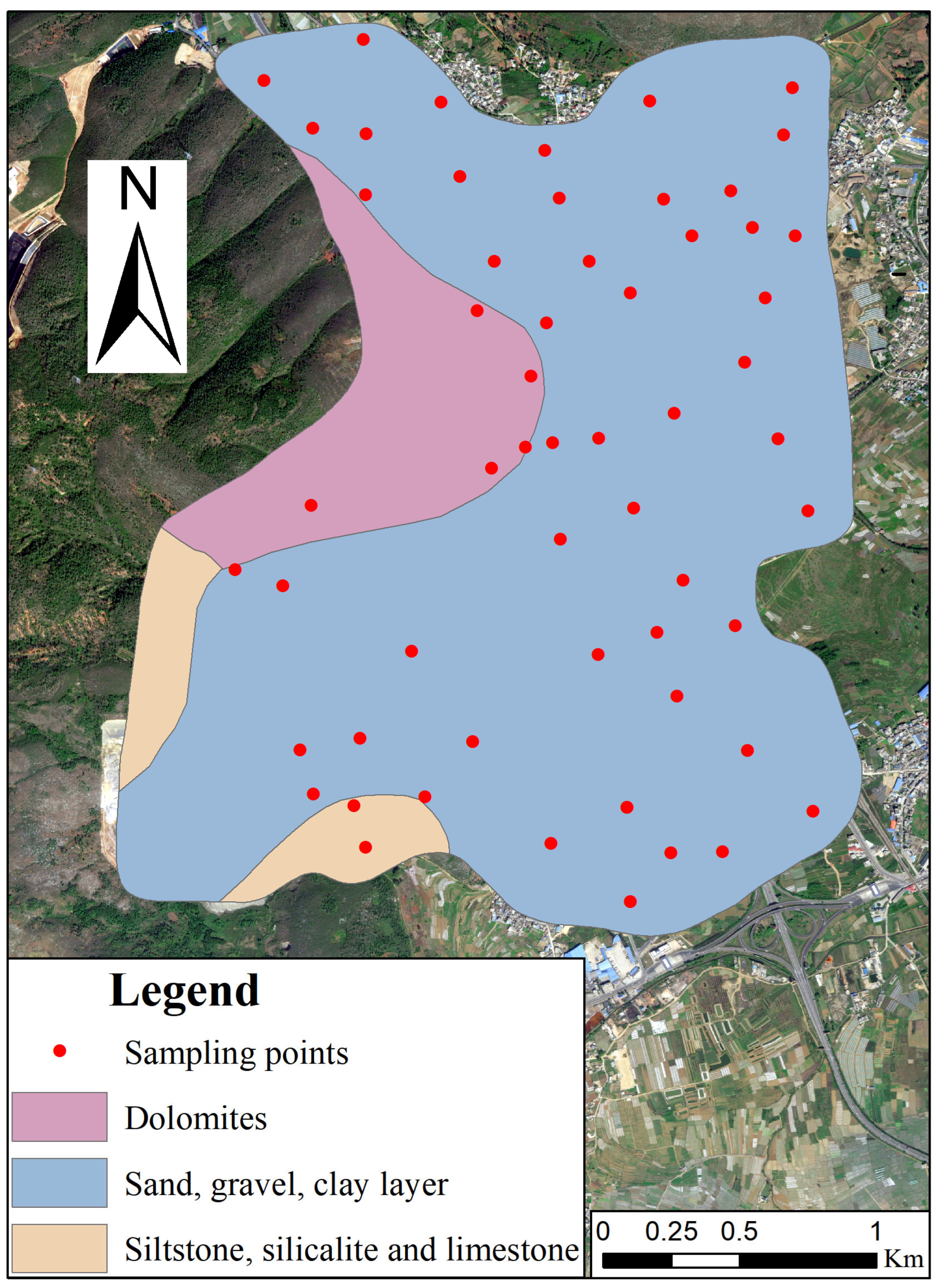
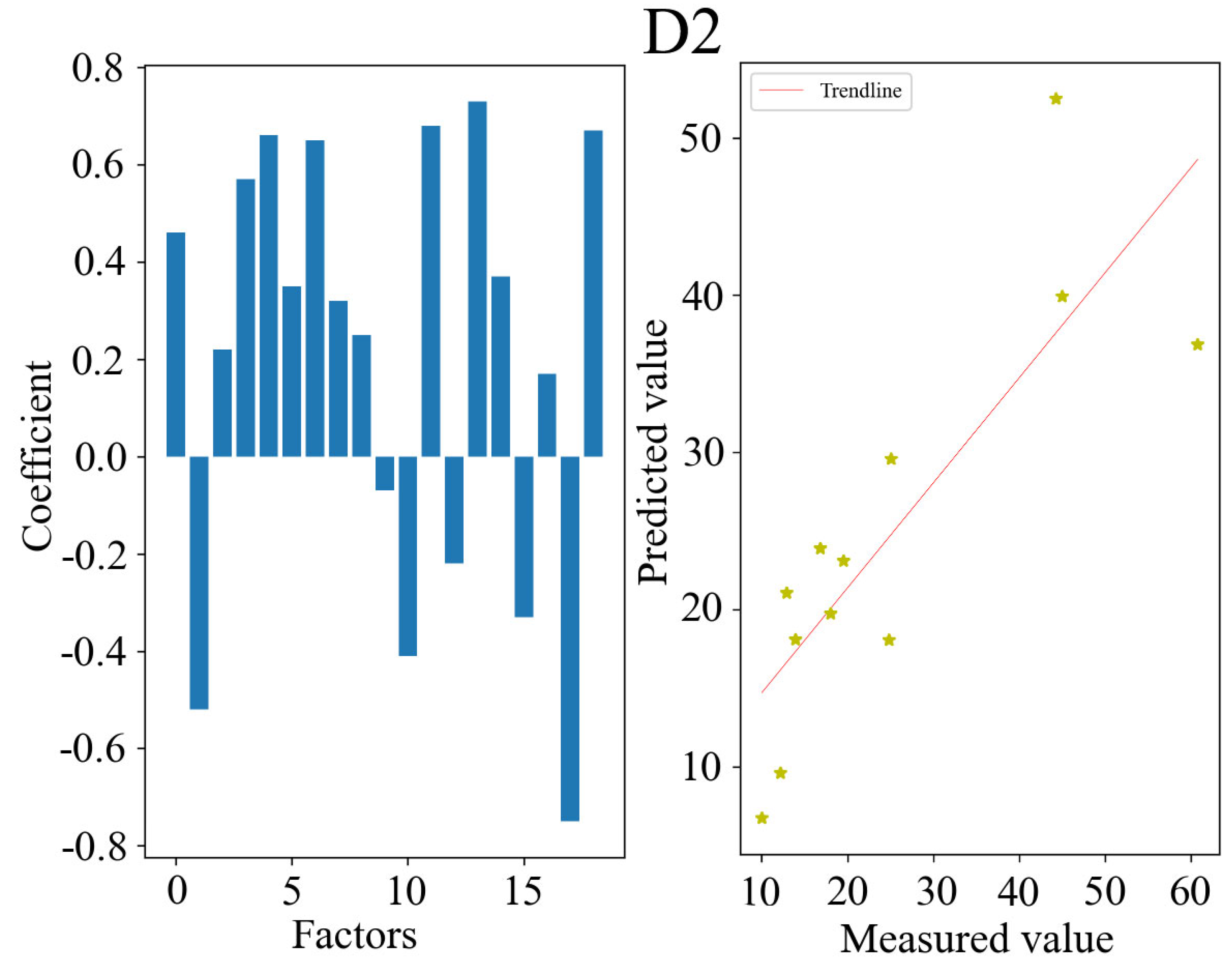

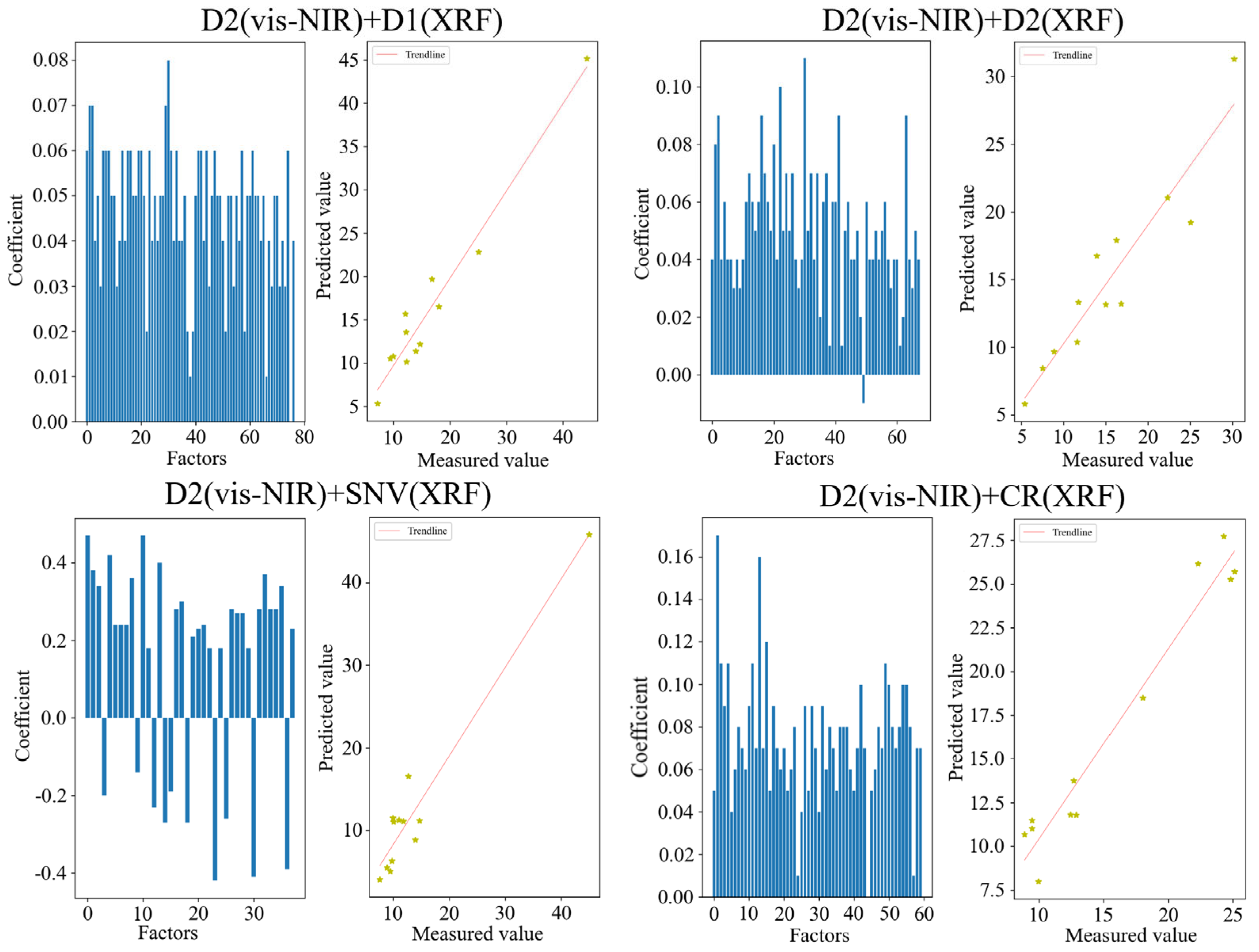
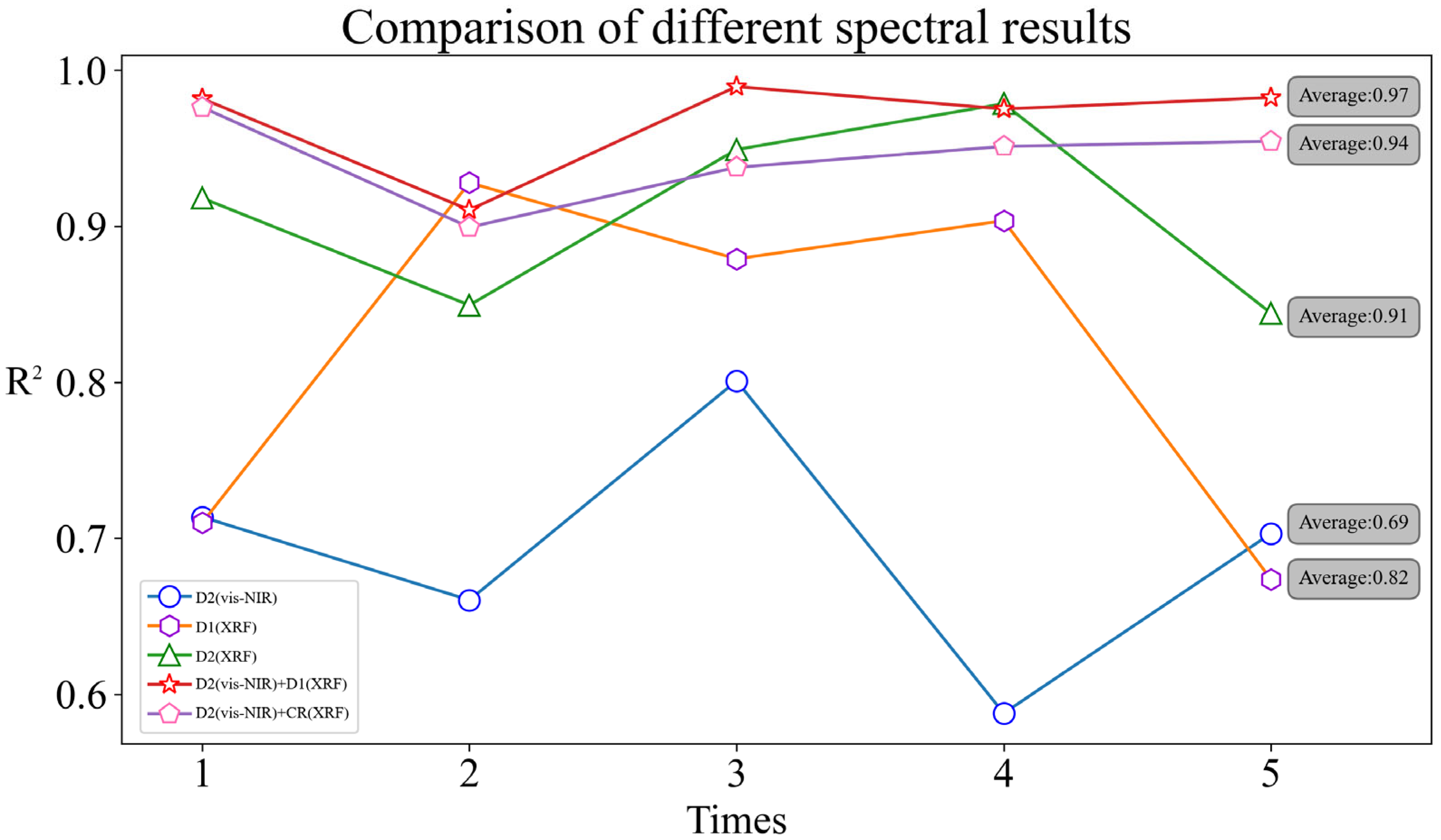
| Element | Mean | Median | Standard Deviation | Minimum | Maximum | Coefficient of Variation | Background Value of Soil in Yunnan Province |
|---|---|---|---|---|---|---|---|
| Cd | 19.8806 | 12.7938 | 16.3516 | 2.9005 | 69.4155 | 82.25% | 0.66 |
| Spectral Type | Transformation | RMSE | R2 | Time (s) |
|---|---|---|---|---|
| vis-NIR | RS | 0.7459 | 0.4054 | 18 |
| CT | 0.4914 | 0.1123 | 339 | |
| SNV | 0.5288 | 0.2971 | 60 | |
| MSC | 0.5141 | 0.4402 | 30 | |
| D1 | 0.5065 | 0.3128 | 34 | |
| D2 | 0.2690 | 0.6849 | 110 | |
| DT | 0.5703 | 0.1405 | 51 | |
| CR | 0.5334 | 0.4781 | 14 | |
| CL | 0.6894 | 0.064 | 37 | |
| XRF | RS | 0.3321 | 0.1082 | 71 |
| CT | 0.4116 | 0.2628 | 59 | |
| SNV | 0.3018 | 0.7495 | 44 | |
| MSC | 0.4531 | 0.3841 | 71 | |
| D1 | 0.1143 | 0.9079 | 113 | |
| D2 | 0.1048 | 0.8868 | 164 | |
| DT | 0.3088 | 0.3772 | 16 | |
| CR | 0.1588 | 0.7442 | 68 |
| Spectral Type | Transformation | RMSE | R2 | Time (s) |
|---|---|---|---|---|
| FS | D2(vis-NIR) + D1(XRF) | 0.1174 | 0.9505 | 65 |
| D2(vis-NIR) + D2(XRF) | 0.1486 | 0.8832 | 34 | |
| D2(vis-NIR) + SNV(XRF) | 0.1904 | 0.8974 | 18 | |
| D2(vis-NIR) + CR(XRF) | 0.1309 | 0.9096 | 23 |
| Spectral Type | Transformation | Mean RMSE | Mean R2 | Mean Time (s) |
|---|---|---|---|---|
| vis-NIR | D2 | 0.5334 | 0.6849 | 110 |
| XRF | D1, D2, SNV, CR | 0.1699 | 0.8221 | 97 |
| FS | D2(vis-NIR) + D1(XRF), D2(vis-NIR) + D2(XRF), D2(vis-NIR) + SNV(XRF), D2(vis-NIR) + CR(XRF) | 0.1468 | 0.9102 | 35 |
Disclaimer/Publisher’s Note: The statements, opinions and data contained in all publications are solely those of the individual author(s) and contributor(s) and not of MDPI and/or the editor(s). MDPI and/or the editor(s) disclaim responsibility for any injury to people or property resulting from any ideas, methods, instructions or products referred to in the content. |
© 2023 by the authors. Licensee MDPI, Basel, Switzerland. This article is an open access article distributed under the terms and conditions of the Creative Commons Attribution (CC BY) license (https://creativecommons.org/licenses/by/4.0/).
Share and Cite
Zhang, Z.; Wang, Z.; Luo, Y.; Zhang, J.; Feng, X.; Zeng, Q.; Tian, D.; Li, C.; Zhang, Y.; Wang, Y.; et al. Quantitative Analysis of Soil Cd Content Based on the Fusion of Vis-NIR and XRF Spectral Data in the Impacted Area of a Metallurgical Slag Site in Gejiu, Yunnan. Processes 2023, 11, 2714. https://doi.org/10.3390/pr11092714
Zhang Z, Wang Z, Luo Y, Zhang J, Feng X, Zeng Q, Tian D, Li C, Zhang Y, Wang Y, et al. Quantitative Analysis of Soil Cd Content Based on the Fusion of Vis-NIR and XRF Spectral Data in the Impacted Area of a Metallurgical Slag Site in Gejiu, Yunnan. Processes. 2023; 11(9):2714. https://doi.org/10.3390/pr11092714
Chicago/Turabian StyleZhang, Zhenlong, Zhe Wang, Ying Luo, Jiaqian Zhang, Xiyang Feng, Qiuping Zeng, Duan Tian, Chao Li, Yongde Zhang, Yuping Wang, and et al. 2023. "Quantitative Analysis of Soil Cd Content Based on the Fusion of Vis-NIR and XRF Spectral Data in the Impacted Area of a Metallurgical Slag Site in Gejiu, Yunnan" Processes 11, no. 9: 2714. https://doi.org/10.3390/pr11092714
APA StyleZhang, Z., Wang, Z., Luo, Y., Zhang, J., Feng, X., Zeng, Q., Tian, D., Li, C., Zhang, Y., Wang, Y., Chen, S., & Chen, L. (2023). Quantitative Analysis of Soil Cd Content Based on the Fusion of Vis-NIR and XRF Spectral Data in the Impacted Area of a Metallurgical Slag Site in Gejiu, Yunnan. Processes, 11(9), 2714. https://doi.org/10.3390/pr11092714







